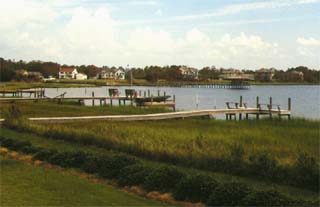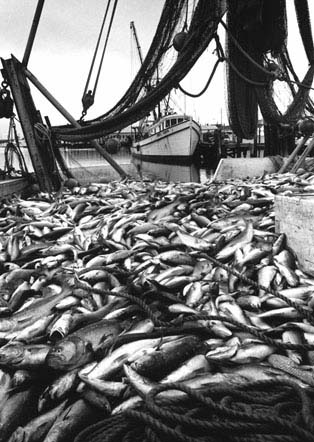 |
| back
to ecological disturbances data |
|
 |
|
| DESCRIPTION
|
COASTAL
COUNTIES |
|
The
North Carolina Division of Coastal Management (DCM) oversees
development in the state's 20 coastal counties. DCM defines
development as coastal land use activities that involve:
-
dredging or filling coastal wetlands or waters,
- construction
of marinas, piers, docks, bulkheads, oceanfront structures
and roads.
Such
activities taking place in or affecting areas designated as
Areas of Environmental Concern by the state in any coastal
county requires a special permit. An AEC is:
an
area of natural importance. It may be easily destroyed by
erosion or flooding; or it may have environmental, social,
economic or aesthetic values that make it valuable to our
state.
This
designation is intended to protect these areas from uncontrolled
development that may cause irreversible damage to property,
public health or the environment. AECs cover almost all coastal
waters and about 3 percent of the land in the 20 coastal counties.
|
| Beaufort |
Hertford
|
| Bertie |
Hyde
|
| Brunswick |
New
Hanover
|
| Camden |
Onslow
|
| Carteret |
Pamlico
|
| Chowan |
Pasquotank
|
| Craven |
Pender
|
| Currituck |
Perquimans
|
| Dare |
Tyrrell
|
| Gates |
Washington
|
|
 |
| photo
courtesy of NC Division of Coastal Management |
|
| ENVIRONMENTAL
IMPACT |
COASTAL
STATISTICS |
|
Development
on the NC coast usually includes the following types of activites:
- Beach
bulldozing
- Beach
nourishment
- Building
- beach
walkways
-
boat ramps
- docks
and piers
- moorings
and arinas
- Bulkheads
and estuarine shoreline stabilization
- Dredging
& excavating channels, canals & boat basins
- Dune
creation and stabilization
- Groins
- House
& oceanfront other construction
- Oceanfront
erosion response
- Sandbags
for temporary erosion control
These
activities impact the ecosystem by
- stirring
up sediment,
- increasing
run off of pollutants,
- reducing
space available to aquatic organisms,
- reduction
or elimination of seagrass habitats,
- altering
current flow in the estuary, and
- increasing
human population along the coast and thus increase human
activities and waste production.
|
The
coast is a popular place to live. Coastal counties represent
only 13 percent of the country's land, but they are home to
more than 50 percent of the nation's population.
In
North Carolina, approximately 10% of the state's 8.3 million
people live in its 20 coastal counties. This percentage has
remained steady over the past 10 years.
- Miles
of ocean beaches in North Carolina: 320
- Miles
of estuarine shoreline in the state: nearly 4,000
- Acres
of sounds, creeks and marshes: 2 million-plus
- Acres
preserved through the N.C. Coastal Reserve Program: 32,000+
- Economic
impact of tourism in the 20 coastal counties in 2001: $1.76
billion
|
- How
does development of the coastal environment impact the estuarine
ecosystem?
- Should
coastal development be eliminated or reduced?
- What
affect does coastal development have on North Carolina's
marine fisheries, particularly blue crabs?
(eire.census.gov/popest/estimates.php;
dcm2.enr.state.nc.us/)
|
|
|
| |
 |
|
| DESCRIPTION |
 |
|
Figure
1. A bloom of Noctiluca in southern
California that produced a spectacular display
of color when the bloom occurred near the
water's surface.
photo
by P.J.S. Franks, Scripps Institute of Oceanography.
(www.nwfsc.noaa.gov/hab/blooms.htm#bloom)
|
|
|
Eutrophication
is a natural aging process of aquatic ecosystems. The ecosystem
becomes more nutrient-rich and more productive with plant and
animal life. This natural process can be accelerated due to
human activities. In this situation, the eutrophication is:
a
process whereby water bodies, such as lakes, estuaries,
or slow-moving streams receive excess nutrients
that stimulate excessive plant growth (algae, periphyton
attached algae, and nuisance plants weeds).
The
enhanced plant growth, a.k.a. algal bloom, reduces dissolved
oxygen in the water when the dead plant material decompose.
The diminished oxygen supply in the water can cause other
aquatic organisms to die.
Sources
of nutrients from human activities include run off of fertilizers
applied to agricultural fields, golf courses, and suburban
lawns; erosion of soil containing nutrients; and sewage treatment
plant discharges.
|
| |
| ENVIRONMENTAL
IMPACT |
|
| Flooding
that results from torrential rains can increase nutrient input
into estuaries due to human activities. Input of excess nutrients
alters the water composition of the estuary. As a result, the
aquatic organisms are affected in various ways. |
| Table
1. Effects of eutrophication on different water
quality and aquatic organisms. |
| |
Effect
if eutrophication persists
|
| Water
quality |
components
that increase
|
components
that decrease
|
- nutrient
concentration
- organic
matter & bacterial decay
|
- dissolved
oxygen concentration
- light
penetration
|
| Seagrass |
Dominant
species replaced by more tolerant, but potentially
less desirable seagrass. Seagrass eventually eliminated,
and replaced by rapidly growing macroalgae. |
| Zooplankton |
Species
diversity is significantly reduced, thus changing
food quality and availability in estuarine food
webs. |
| Invertebrates
(crab, shrimp, mollusks, polychaetes) |
Species
diversity and abundance is significantly reduced.
|
| Vertebrates
(fish) |
Reduces
and eliminates senstive fish. Spawning and recruitment
depressed due to reduction in oxygen availability.
Shifts dominant fish species towards those that
are tolerant to low oxygen concentrations. Reduction
in size and abundance of herbivorous fish. |
|
|
- How
does a decline in water quality affect blue crabs?
- What
affect do hurricanes have on eutrophication of an estuarine
ecosystem?
- How
do you think the 1996 and 1999 hurricanes impacted the Albemarle-Pamlico
Estuarine Ecosystem?
|
(Burkholder,
2001; www.nwfsc.noaa.gov/hab/blooms.htm#bloom; toxics.usgs.gov/definitions/eutrophication.html)
|
|
|
| |
 |
|
 |
Fishing
has had a long history in North Carolina's economy and coastal
heritage. North Carolina's rich estuarine habitat has established
it as one the top ten states in the nation in both recreational
and commercial annual marine fish landings. North Carolina's
marine fishery contributes approximately one billion dollars
annually to the state's economy.
Refer
to the Human Activities Data
for
more information ecological effects of fishing in North Carolina.
|
-
North Carolina's fishing tradition has grown tremendously
over the years. Increased fishers and improved fishing capabilities
continue to take from its estuarine and coastal ecosystems.
How can this pose a challenge to the fish and shellfish
population?
|
| photo
courtesy of NC Division of Marine Fisheries |
|
|
| back
to ecological disturbances data |
|
| |
This web
site was created by Lynn Tran at the North Carolina State University, Department
of Mathematics, Science, and Technology Education on 7/12/03. Faculty advisor
Dr. David Eggleston, NCSU, Department of Marine, Earth, & Atmospheric Sciences.
Last updated
December 29, 2003
.
|